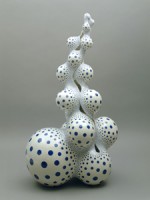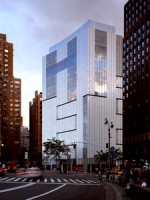Column Name
Title
In September 2008, a newly redesigned building opened at 2 Columbus Circle in Manhattan. You might have noticed the quirky building, just a quick walk from Juilliard. Short, stocky, both beautiful and homely, it stands apart from its tall and stately Columbus Circle neighbors. You may also have wondered what was inside. It might surprise you that this controversial building houses a distinctive and very special museum. Commonly known by its acronym, MAD, the Museum of Arts and Design contains everything from very large glass, ceramic, wood, and steel sculptures to tiny and delicate pieces of jewelry and embroidery.
Body
When the architect, Edward Durell Stone, first designed the building in 1965, people said it looked like a Bauhaus version of the Alhambra—or, as Ada Louise Huxtable, then the architecture critic at The New York Times, put it, “a die-cut Venetian palazzo on lollypops.” After five years, the Huntington Hartford Gallery of Modern Art, as it was first known, failed. The building was scheduled for demolition, but due to pleas from a number of preservationists, it was rescued and eventually bought and taken over by the American Craft Museum (originally located on 53rd Street, across from the Museum of Modern Art). A new design for the building was proposed by Brad Cloepfil.
To redesign the building, Cloepfil used 22,000 terra-cotta tiles specially made with a slightly iridescent glaze; this had the effect of relating the exterior to the function of the new museum. He also wove three ribbons of glass across the facade. Continuing inside the building, the glass provides views that connect the interior with New York City from all four sides.
In 2002, the American Craft Museum changed its name to the Museum of Arts and Design. This name change was more important than it might at first appear. “Crafts” used to be the catchall name for “Arts’s” less important, “lower,” more utilitarian stepsister. But now, instead of accepting second class citizenship, the museum’s goal is to transcend boundaries formerly imposed on “crafts.” It also wants to stress inclusiveness by striving to present international art and serve as an educational resource.
This museum has a long history of being ahead of its time. In existence for nearly half a century under its former name, its collection, limited to contemporary objects created in craft media—such as clay, glass, wood, metal, and fiber—is an integral part of today’s art world, which no longer believes that it’s necessary to separate out “crafts” from art. Indeed, most contemporary artists use some form of “craft” in their work. Institutions such as the Museum of Modern Art and the Metropolitan Museum of Art have long included architecture, fashion, interior design, technology, and performing arts in their collections.
With triple the space of its previous facility, the new building allows for the first time galleries dedicated to the exhibition of MAD’s permanent collection. In the third-floor galleries, we can see approximately 250 works by artists such as Louise Bourgeois, Roy Lichtenstein, George Segal, and Faith Ringgold. These works would be at home in any “art” museum. Some examples of specific pieces from the large permanent collection follow:
Harumi Nakashima’s Struggling Form, 2002, stands 3½-feet tall. The artist’s signature dotted patterns over ceramic reminded me of the work of Yayoi Kusama, an influential artist born in 1929. Like Kusama, Nakashima employs an unusual combination of personal expression and the impersonal. The reference to Pop Art is a surface one; the bubbly forms appear organic and vulnerable, still maintaining a slick and smooth exterior.
Susan Point’s large, elegant Return is made of cast glass with stainless steel and acrylic paint, on a base of red cedar wood. It is both delicate and illusionistic, looking like a reflecting soap bubble, but also like a spindle. Point, who was born in British Columbia, has etched traditional motifs from her ancestral northwest coast culture onto the glass.
Several new temporary exhibitions are scheduled for October:
“Read My Pins: The Madeleine Albright Collection” includes more than 200 pins that Madeleine Albright, the first female secretary of state, wore during her tenure as the highest-ranking woman in the Clinton administration. She claimed that she wore the pins to indicate and reflect personal and political situations. “I found that jewelry had become part of my personal diplomatic arsenal,” Albright has said. “While President George H.W. Bush had been known for saying ‘Read my lips,’ I began urging colleagues and reporters to ‘Read my pins.’” After Saddam Hussein’s press referred to her as a “serpent,” for example, she wore a golden snake brooch to her next meeting on Iraq. The incredible gold serpent in the exhibit coils around a gold branch, dangling a diamond from its mouth. Dating from c. 1860, its maker is unknown.
Another show is “Slash: Paper Under the Knife.” This promises to be a fascinating exhibit, emphasizing the essential role of paper in today’s art. It will feature a multitude of treatments of paper, from burning to cutting with laser to tearing and shredding. In one section of the exhibition, books are modified and transformed into sculptures. Another will highlight the use of cut paper for film and video animations.
MAD has ongoing open studios featuring artists at work, and visitors are invited to observe the process and ask questions of the artists in residence. The museum also has a wonderful store and a new panoramic restaurant on the ninth floor.
The quality of the rich permanent exhibit and the temporary ones of MAD challenge those of the Museum of Modern Art, which has a fascinating exhibition right now of design works by Ron Arad. The show, titled “No Discipline,” runs until October 19. Arad, also represented in MAD’s permanent collection, is just the kind of artist/designer/architect whose work resists categorization.
It is clear that the distinctions between “High and Low” and “Arts and Crafts” have just about evaporated. The Museum of Arts and Design takes its place proudly along with other major art museums of New York City.
“Read My Pins: The Madeleine Albright Collection” runs through January 31. “Slash: Paper Under the Knife” runs October 7-April 4. Both are at the Museum of Arts and Design, 2 Columbus Circle. The museum is open Tuesday through Sunday from 11 a.m. to 6 p.m., and Thursday from 11 a.m. to 9 p.m.; it is closed on Monday.






